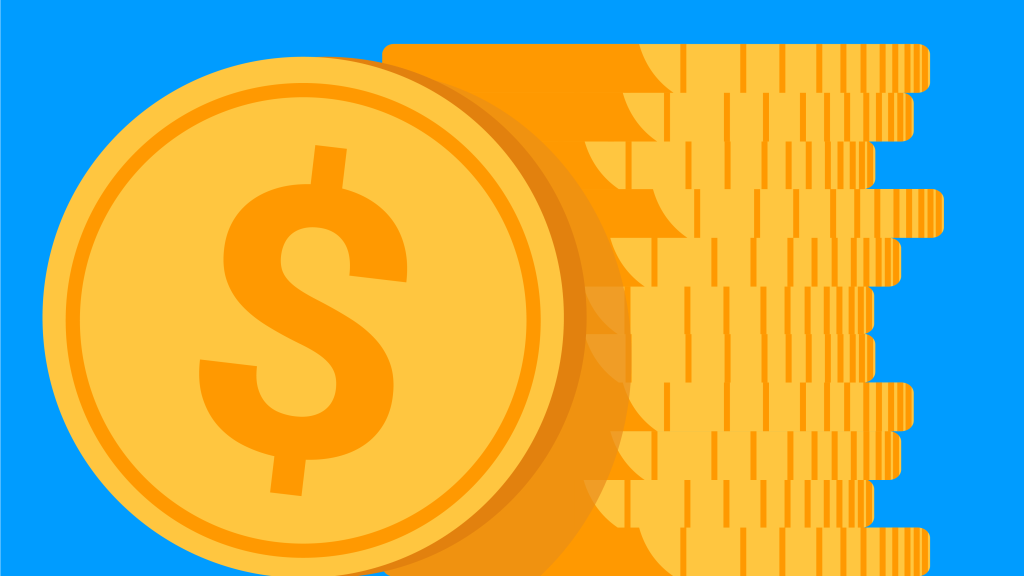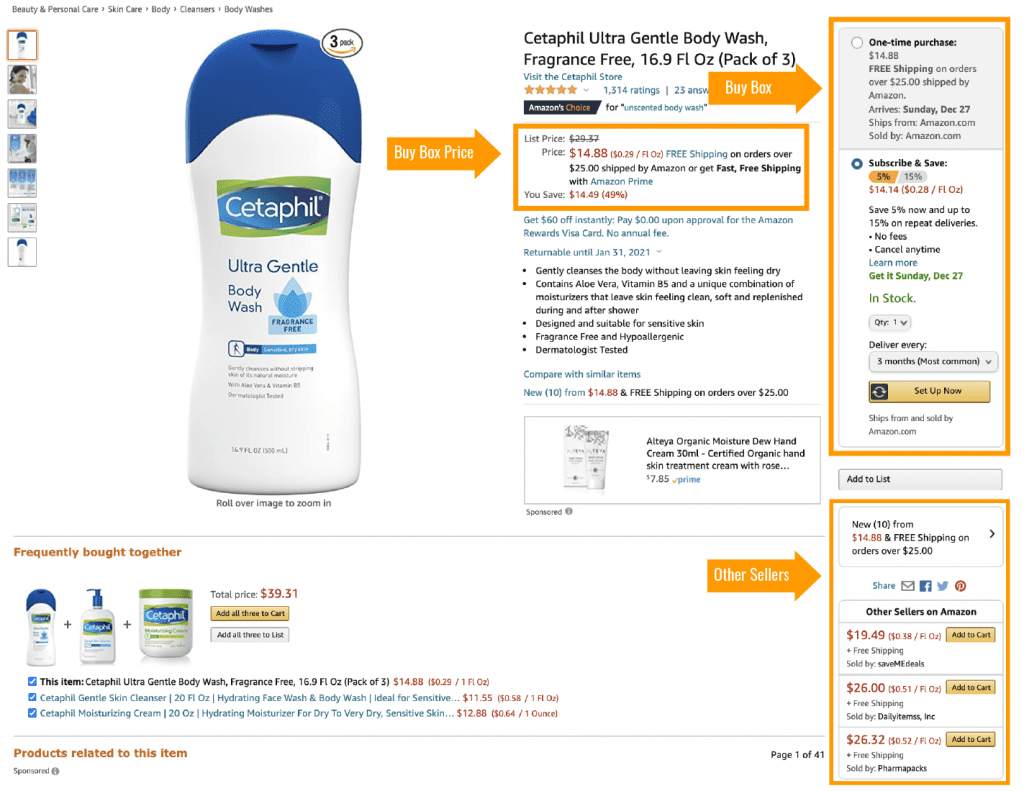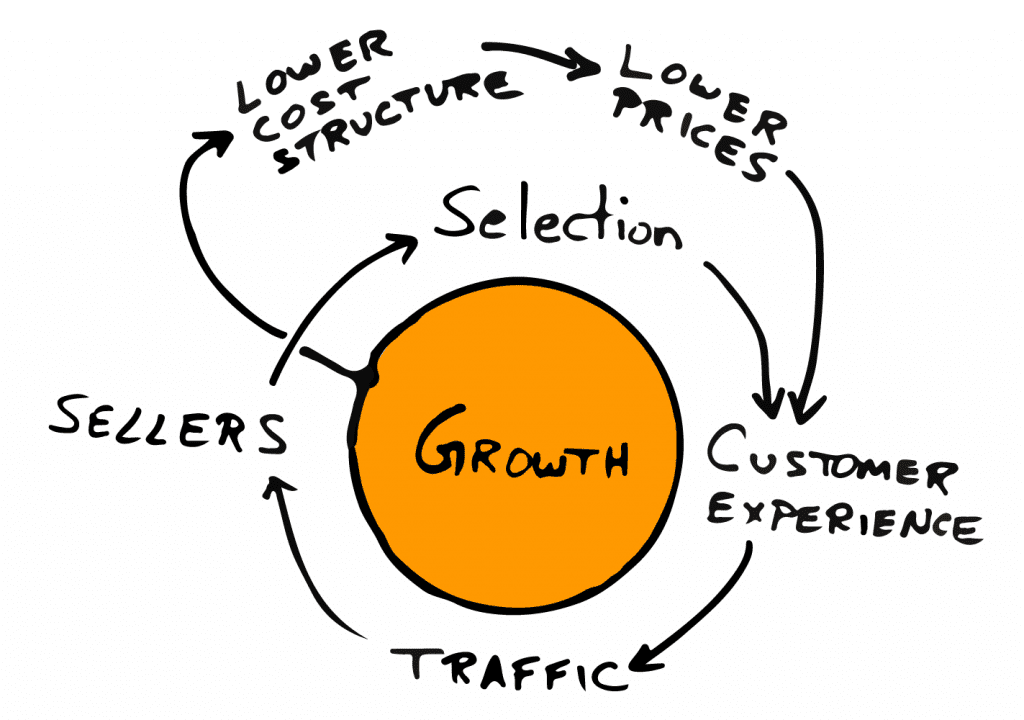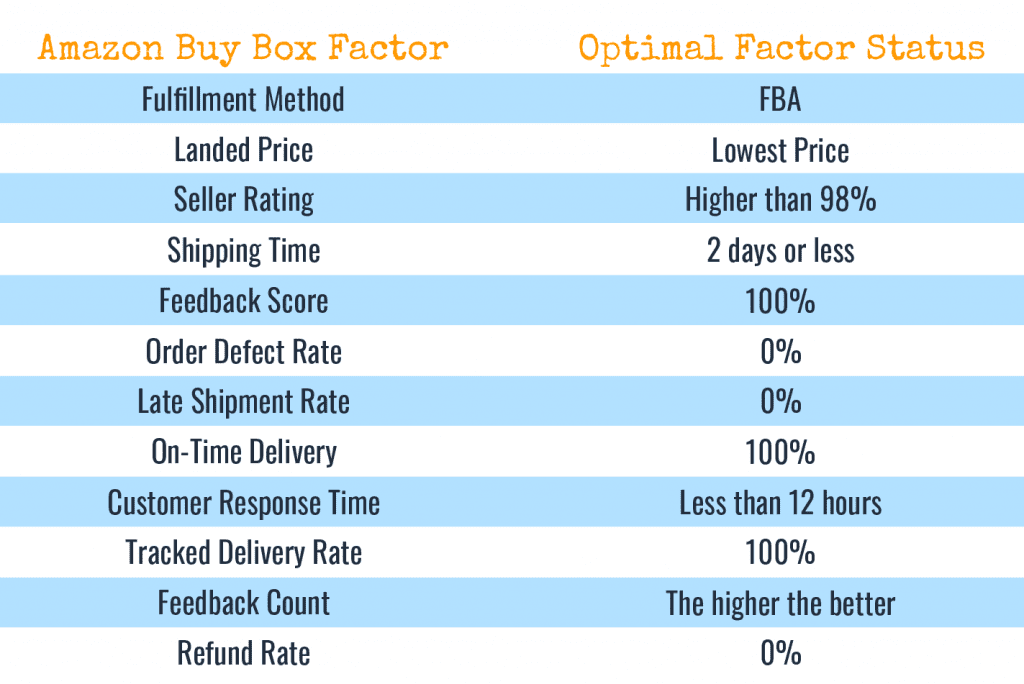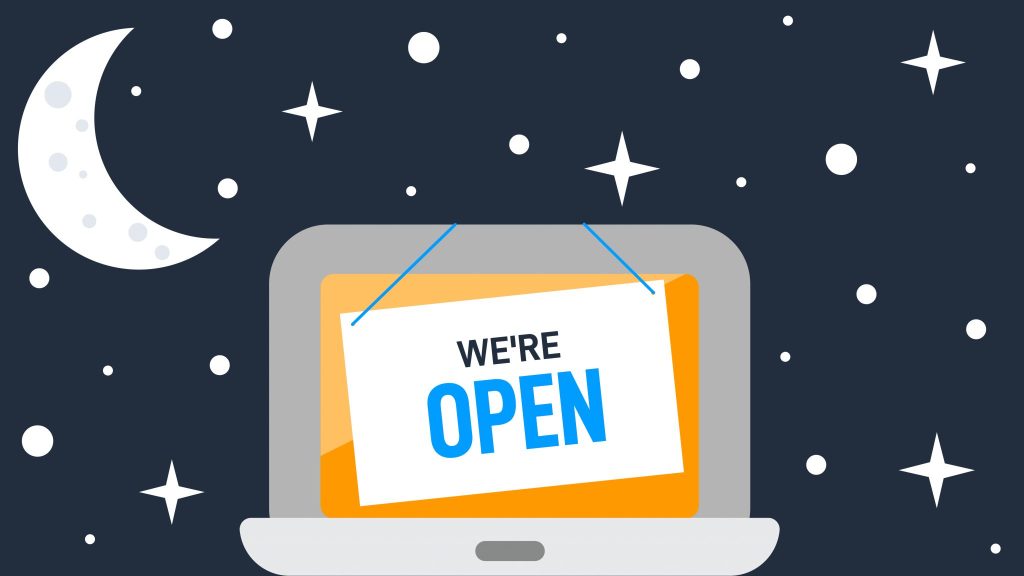
You’ve finally found it…
This article is designed for those that want to learn how to make money online.
Even if you have no idea how or where to start, that is okay – because I am going to be showing you.
This is a blueprint; a blueprint to building an online revenue stream that makes you money even while you sleep. As a matter of fact, I did $6,496 in sales last night while I was snoozing.
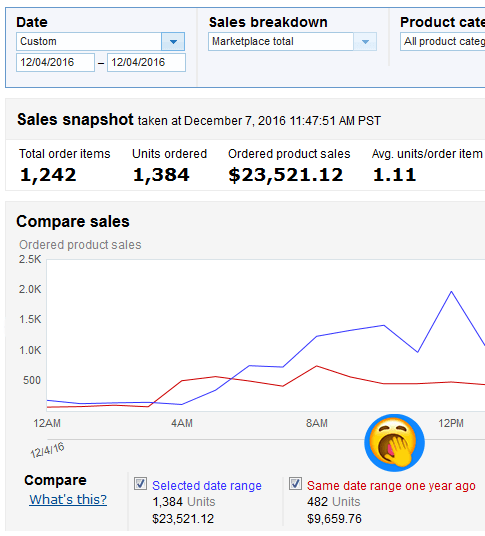
$23,521 in sales for the entire day, but a whopping $6,496 came in the hours while I slept as you can see from the chart above. Did you notice the yawning emoji around the 10:00 AM mark? I put that there because it’s around the time I wake up each day. Sometimes earlier, sometimes later.
I get up when I wake up.
I’m afforded this luxury because I don’t have a job. I have a business.
I don’t miss my daughters’ gymnastics practices anymore, I don’t suffer through restless nights worrying about rumors of company downsizing, or feel as though I am underappreciated and underpaid.
What kind of business do I have that affords me these things?
An Amazon business.
Put quite simply, I sell physical products on Amazon. A lot of them. And this page is here to show you the exact business model step-by-step so that you can copy it.
10 years ago my business partner Dylan and I were working regular office jobs. We made a living and nothing more. And then one day we were presented with information about the opportunity of selling on Amazon just like this article is about to teach you about that same opportunity.
Naturally, we were skeptical, but we felt we had nothing to lose and everything to gain.
The problem was we had no money.
Like many Americans, we were living paycheck to paycheck. There just wasn’t extra money laying around to start a business with, but we didn’t let that stop us.
I had basically no credit history at the time. That means we got started with a $600 limit credit card in my name (the most I could get approved for) and that was it.
We worked nights and weekends building our Amazon business.
6 months later we were earning enough to leave our jobs.
10 years later and we’ve sold over $35 million dollars on Amazon.
WARNING
Before we dig in, I’ve got to warn you about something that’s critically important. Not paying attention to this will virtually guarantee you never make real money online.
Up to this point, I have mostly talked all sunshine and rainbows. If you honestly think that you are going to read this 6 step guide and make $5,000 over the next 30 days…then you are on a fool’s errand.
It’s true that my business generates well over a half-million dollars in revenue each month and I work 6 hours a week at most, but I had to work my butt off over the last 5 years to get to this point. I am not an overnight success and this is not a get rich quick scheme.
This is a “put in the hard work, dedicate yourself and build a viable online business that will stand the test of time”…actionable plan.
Also, please realize that this is just a blueprint. I can’t break down everything I know and have learned about starting and operating a 7-figure Amazon business in a single blog post. What you will gain, is the knowledge and direction you need to get started building an online income for you and your family. Everything else after that is up to you.
You have now been thoroughly warned. If you fully understand that successful businesses are built not by chasing unicorns, but with sweat equity…then you should continue reading.
So let’s get started…
The System
The system my business partner Dylan and I have used to create a multi-million dollar online business is not new or revolutionary in any way. Actually, it has existed pretty much forever.
It’s the same system used by Wal-Mart, Target, and Costco.
The system, in its simplest form, is this:
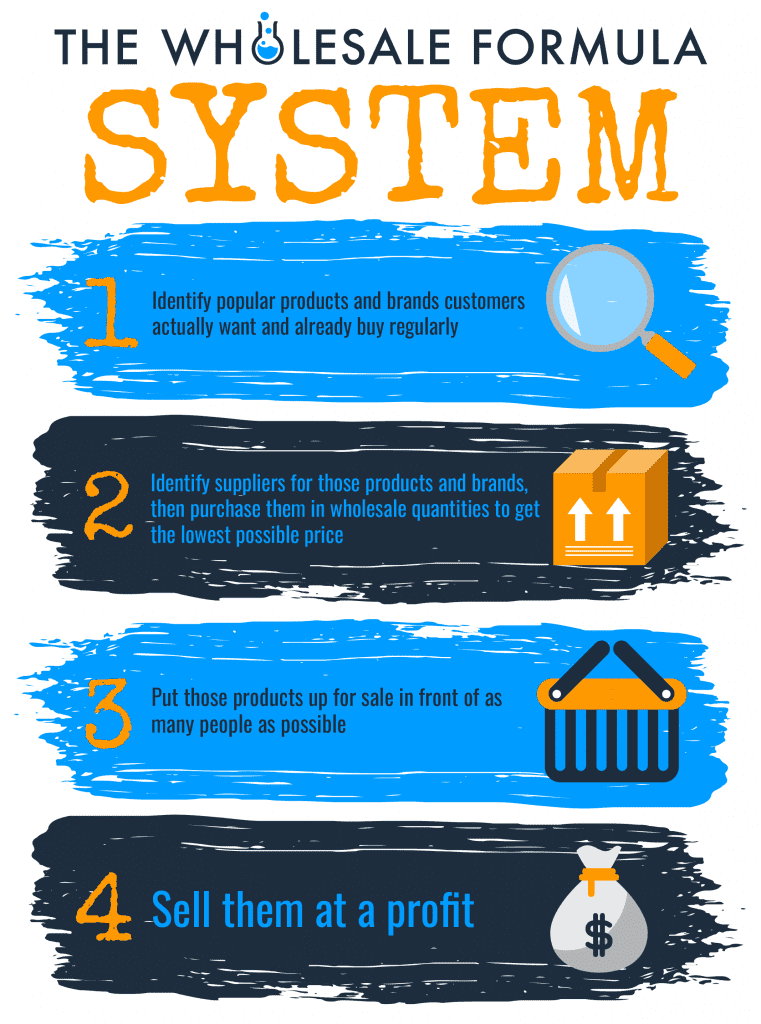
It really is that simple. We buy low (wholesale prices) and sell high (retail prices).
We call this process wholesale.
Now here is the secret sauce; the thing that makes the wholesale business model possible for just the average person like you and me to replicate.
Amazon.com
I repeat. Amazon.com
For decades, the hardest part to replicate in the business model for the average Joe was part C.) putting products in front of enough customers. It required a lot of money to have enough retail space to store and display all that product and even more money for the marketing and promotion to get people into your store and buying.
Amazon has completely revolutionized online business forever because their massive marketplace will do that part for you. This makes it possible for almost anyone at any level, people like you and me, to start an online retail business.
This leads us right into the first of our 6 steps…
Step 1 – Understand the Amazon Marketplace & Opportunity
(AKA – Amazon.com is where you are going to sell your sh*t)
If you are going to be selling stuff on Amazon, it is important to understand what exactly Amazon is and how it works.
You might roll your eyes at the fact that this is a step at all, but I fully believe this is the most important step there is. The opportunity for people to totally change their life is right at their fingertips, 24 hours a day, 7 days a week and they don’t even know it exists.
Let’s break it down.
Amazon is the world’s largest online marketplace. That means more stuff is bought and sold on Amazon.com than anywhere else online (and it isn’t even close).
The keyword here is “marketplace.”
When you shop on Amazon and purchase a product, there is a really good chance that the product you bought was not actually sold by Amazon. Yes, you bought it on the Amazon website, but the real seller (the person who listed the product for sale on Amazon.com and gets paid for the sale) is just an average Joe. Heck, it could be me. It could be the guy or gal down the street. And after finishing this blog, it could be you!
Over half of all products sold on Amazon.com are sold by 3rd party sellers like me.
HALF!
Ready to have your wig blown off?
Amazon did over 450 billion dollars in revenue for 2021 and they are still rapidly growing.
Do I really need to do the math for you? 450 billion in revenue, 60% of sales coming from 3rd party sellers like me and Joe down the street.
WOAH! That is a lot of money.
Amazon is basically waving around BILLIONS of dollars just begging people to come claim it.
If you are wondering what it costs or how hard it is to sign up as a seller…well…it is FREE. You can complete the application process in about 15 minutes and BOOM, you are live to start selling. It is so easy that it would be hard for you to make up an excuse NOT to do it.
But there has to be a catch, right? Well, sort of. Amazon takes a commission on every sale that is made on their website (and we gladly pay it).
Remember a second ago when I said for centuries the hardest part about owning a retail business was getting your products in front of as many people as possible? If you owned a physical retail store in your local city, on a good day you might have 50 people come into your store to browse.
By comparison, over 100 million people shop on Amazon each month.
WOAH! That is a lot of people.
Amazon provides the customer base so that you can easily sell tens, hundreds, or even thousands of products every single day.
But what about the delivery of those products? Even if you were able to sell that many products, how would you actually go about shipping out all those orders?
Well…Amazon will actually do all that for you too. And more.
This leads us to our next step…
Step 2 – Understand the Amazon FBA Program
(AKA – How you can sell millions of dollars worth of products without ever having to physically see or touch them)
FBA stands for Fulfillment by Amazon.
It is easily one of the most revolutionary leaps forward for business in the last half-century. It is exactly what has enabled Amazon to generate half of its retail revenue from 3rd party sellers.
To explain what exactly FBA is, I will let you hear it straight from Amazon themselves with this two and a half minute video.
With FBA, Amazon will store all your products in their warehouse, prep, and ship the products to customers for you, and handle all customer service and returns.
This means you can have your product suppliers just ship directly to Amazon’s warehouses. You can literally sell millions of dollars’ worth of product without ever having to physically see or touch it.
With FBA, you can accomplish by yourself from your living room what would have taken a warehouse and a team full of employees just 10 years ago.
So, what does it cost to enroll in FBA?
This is the crazy part. Enrolling in the Amazon FBA program costs you nothing upfront. You only pay a per-item fee for products when they actually sell.
Step 3 – Create Amazon Seller Account and Sign Up for FBA
(AKA – Take 15 minutes of time out of your day to change your life)
This is the fastest and easiest step. I have already gone into detail about the benefits of selling on Amazon and using the FBA program.
All you have to do here is commit. Commit to whatever it is you want to accomplish. With Amazon FBA, you can go as big or small as you want.
Whether you just want to make extra money to save up for that vacation your husband/wife always wanted, or you want to build a highly profitable business that will serve as a lasting legacy for you and your family, it is all possible with FBA.
To get started making those goals a reality, all you have to do is set up an Amazon seller account.
You can create your seller account right here:
Step 4 – Find Products to Sell
(AKA – Don’t reinvent the wheel; find the most popular wheel and sell it!!)
So, what do I sell?
The answer to that question is very simple. You sell what people are buying.
Picking the right products is the key to a successful e-commerce business. You make the wrong move here and you will end up spending your money on a bunch of junk that never sells.
Our framework for identifying products that will sell fast and make you money is a huge pillar of our training program The Wholesale Formula.
I have some good news and bad news about that.
The bad news is that you likely can’t get into The Wholesale Formula right now. We only conduct the program a couple of times per year and enrollment generally only lasts about a week. The program is also not cheap. We don’t just go around giving away ALL of our business secrets for free.
The good news? I will give you a summarized version of how we source products right here.
Sourcing = The process of searching for products to sell
There are two ways people traditionally source for products to sell on Amazon:
- Going to tradeshows or signing up for accounts with distributors and wholesale companies. They will then go through those companies’ giant catalogs of branded inventory to find products they can buy to profitably resell on Amazon.
- Contacting Chinese manufacturers and having them put your own brand name on generic products that you will launch on Amazon. This process is called private label.
We don’t do either of those things.
Both of those strategies for sourcing products are harder, more time-intensive, and riskier.
How we source starts with our Reverse Sourcing concept. It is one of the major things we have developed that allowed us to succeed where many others have failed.
With Reverse Sourcing, we do things the safe and easy way.
You don’t have to take big risks to make big money. Not on Amazon.
Enter our method of Reverse Sourcing.
We start our search for products on Amazon itself. Remember when I said that you want to sell what people are buying? Well, Amazon actually tells you how often people are buying a product right there on the product page. It is called Amazon Best Sellers Rank.

And with some quick math, you can even estimate how many of that product you can sell per month. It’s really is a formula to success and is a hallmark to how we came about the name The Wholesale Formula.
After we have used our formula to identify great potential products comes the next step, which again is VERY different from conventional wisdom in the industry.
We don’t go to major distributors or wholesale companies to purchase those awesome potential products we just found on Amazon. Instead, we cut out those middlemen and go straight to the source.
We reach out to the brand owner to open up a wholesale account with them directly.
When you buy direct, you get the best possible price. And when you get the best price, you make the most money!
 Step 5 – Learn How to Buy Products Brand Owner Direct
Step 5 – Learn How to Buy Products Brand Owner Direct
(AKA – Buy a cow from a farmer instead of milk from the store)
This may be the trickiest part of our blueprint.
It makes perfect sense that cutting out the middleman and buying direct is going to make you more money, but if it were that simple, everyone would be doing it.
Oftentimes, brand owners won’t approve just anyone to sell their products on Amazon. Their brand is their entire life’s work and they don’t entrust it to just anyone. They are looking for certain qualities and attributes in their online sellers.
This part of the process is what we call The Great Filter. That’s because this is where the majority of people fail with this business model. They never figure out how to break through and get approved to sell these amazing products.
Luckily, we have cracked the code.
There are 2 primary attributes brand owners are looking for
They want sellers who:
- Appear professional & trustworthy
- Add value to their products and brand
Let’s analyze these a little deeper. How do you appear more professional and trustworthy? Well, for one you have to remember that this will be a business to business relationship, so you actually want to appear and present yourself as an actual business.
(You know, don’t send emails using a Hotmail address; stuff like that.)
Having a professional business website that represents your company is a great way to help legitimize you in their eyes.
When it comes to adding value to their products and brand, it is pretty simple. They want sellers that will contribute to the growth of their brand. They don’t want a leech that is going to sell their product and nothing more.
You add value by doing things like improving the product page on Amazon, running pay-per-click advertising, and a myriad of other ways. Some of these may seem daunting but trust me, they really aren’t. We learned them on our own and have taught hundreds of The Wholesale Formula students how to successfully add value to brands, so don’t worry, you can figure it out too.
You just have to ask yourself a simple question – “What is one thing I can do that will increase the sales, perception or exposure of this product/brand?”
The answer to that question is how you add value, and it is how you will convince a company to approve you as a seller.
Once you’ve mastered this, it is like having a license to print money.
Step 6 – Sell Products on Amazon
(AKA – Imagine having the world’s largest 24- hour convenience store fully ran by robots)
This is the fun part. Checking your phone to see how many products you have sold, and how much you’ve done in sales. It seriously becomes addicting. You will be doing it constantly.
Because you are using the power of Amazon FBA, you have a full-scale business operating around the clock. After you watch a movie on Netflix, you check your phone and “Oh, I did $1,100 in sales during that movie”. Maybe you hit the beach for a few days, come back, and check your phone “Bam! I did $8,430 in sales while I was catching that surf and sun.”
If this sounds totally cheesy and ridiculous, that’s because it is. It is absolutely ridiculous, but it is all true and it is all real.

